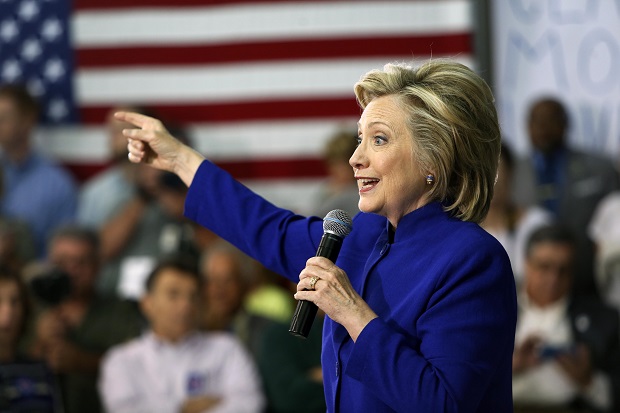
Democratic presidential candidate Hillary Rodham Clinton speaks during a campaign stop at River Valley Community College Tuesday, Aug. 11, 2015, in Claremont, N.H. (Photo by Jim Cole/AP)
WASHINGTON — Neither of the two emails sent to Hillary Rodham Clinton now labeled by intelligence agencies as “top secret” contained information that would jump out to experts as particularly sensitive, according to several government officials.
Still, it’s looking increasingly likely the issue of whether Clinton mishandled classified information on her home-brew email server will have significant political implications in the 2016 presidential campaign.
Clinton, the front-runner for the Democratic nomination, agreed this week to turn over to the FBI the private server she used as secretary of state. And Republicans in Congress have seized on the involvement of federal law enforcement in the matter as a sign she was negligent in handling US secrets.
While polls show Clinton retains a commanding lead over her Democratic presidential rivals, her attempts to focus her campaign on issues like education and economic recovery have been complicated by constant questions surrounding her decision to run her State Department email correspondence through an unsecured system set up at her suburban New York home.
One of the now “top secret” emails included a discussion of a US drone strike, part of a covert program that is widely known and discussed. A second conversation could have improperly referred to highly classified material, but it also could have reflected information collected independently, US officials who have reviewed the correspondence told The Associated Press.
On Monday, the inspector general for the 17 spy agencies that make up what is known as the intelligence community told Congress that two of 40 emails, in a random sample of 30,000 messages that Clinton gave the State Department for review, contained information deemed “Top Secret,” one of the government’s highest levels of classification.
While neither of the emails was marked classified at the time they were sent, they have since been slapped with a “TK” marking, for “Talent Keyhole,” suggesting material obtained by spy satellites. And they also were marked “NOFORN,” meaning information that can only be shared with Americans with security clearances.
The two emails got those markings after consultations with the CIA and other agencies where the material originated, officials said. Some officials said they believed the designations were a stretch — a knee-jerk move in a bureaucracy rife with over-classification.
The officials who spoke to the AP on condition of anonymity work in intelligence and other agencies. They wouldn’t detail the full contents of the emails because of ongoing questions about classification level.
In a four-page fact sheet that accompanied a letter to Clinton supporters, Clinton spokeswoman Jennifer Palmieri stressed that Clinton was permitted to use her own email account as a government employee and that the same process concerning classification reviews would still be taking place had she used the standard “state.gov” email account used by most department employees. The State Department, meanwhile, stressed that it wasn’t clear if the material at issue ought to be considered classified at all.
But even if the emails highlighted by the intelligence community prove innocuous, Clinton will still face questions about whether she set up the private server with the aim of avoiding scrutiny, whether emails she deleted because she said they were personal were actually work-related, and whether she appropriately shielded such emails from possible foreign spies and hackers.
The State Department advised employees not to use personal email accounts for work, but it wasn’t prohibited.

